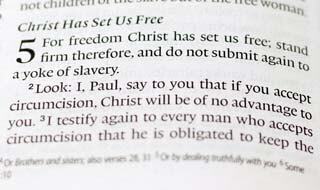“That ye put off concerning the former conversation the old man, which is corrupt according to the deceitful lusts; And be renewed in the spirit of your mind; And that ye put on the new man, which after God is created in righteousness and true holiness.” Ephesians 4:22-24, KJV.
The interpretation of man’s essential nature as referenced in this exhortation in Ephesians 4:22-24 is pivotal to one’s view of sanctification. And this doctrine is essential to the biblical counseling model employed to guide a defeated Christian to victorious life in Christ.
A key issue to be clarified here is the meaning of “old man” in this context and how it contrasts with the “new man.” Let’s review the two other passages where the term “old man” occurs:
Romans 6:6: “knowing this, that our old man was crucified with [Him], that the body of sin might be done away with, that we should no longer be slaves of sin.”
Colossians 3:9: “Do not lie to one another, since you have put off the old man with his deeds”
Notice that the other two texts view the old man as HAVING BEEN crucified and already “put off” (past tense). So if the old man is no longer the identity of the child of God, why does this text in Ephesians seem to view the old man as still present in the believer? It sounds like the old man has not actually been”put off” or “crucified” yet; rather, the believer should do this. Since the New Testament pattern is to present doctrine and then apply it to practical issues of life, the doctrinal underpinnings of Ephesians 4:22 need to be clear so the exhortation of the verse can be more readily accomplished.
In Ephesians chs 1-3 believers have been (past tense) saved, regenerated, and sealed by the Holy Spirit; they were raised with Christ and are seated with Him in the heavenlies! (Eph. 1:13; 2:1-10).
As we check the Greek lexicon we see the basic definitions used in Ephesians 4:22. Old: “palaios” is an adjective meaning “old, ancient; no longer new, worn by use, the worse for wear” (Thayer). Vines Expository Dictionary states: “‘Old’ …of what belongs to the past, e.g., the believer’s former self before his conversion, his ‘old man.'” “Man” is “anthropos” which occurs over 500 times. It means “a human being, whether male or female.” It has more precise uses also: “to distinguish man from beings of a different order; with reference to two fold nature of man, body and soul [material immaterial]; with reference to the two fold nature of man, the corrupt [fleshly] and the truly Christian man [Spirit-filled], [which is] conformed to the nature of God (Thayer; bracketed words added).
We agree with deeper life authors who define the “old man” as the unregenerate human spirit, i.e., who a person was in Adam as identified by his previous spiritual condition (death and depravity). This is an essential concept in order to differentiate the “old man” (which in the believer was crucified with Christ and is out of the picture) and the flesh and Sin principle (which is an ongoing nemesis – Gal. 5:16,17; Rom. 7:17).
Yet, Ephesians 4:22 has been used to support the idea that the old man is still present in the believer, So, let’s take a closer look. “That you PUT OFF, CONCERNING YOUR FORMER CONDUCT, the old man which grows corrupt according to the deceitful lusts, and be renewed in the spirit of your mind, and that you put on the new man which was created according to God, in true righteousness and holiness.(Ephesians 4:22-24 emphasis added).
Before we more closely analyze the definition of “old man” in this verse and its implications, consider the verb form that is used with it here–“put off.” This is from the Greek “apotithemi” meaning “to put off or aside or away.” It occurs eight times in the New Testament and refers to putting off clothing. This is the literal use in Acts 7:58: “…and the witnesses laid down [“apotithemi”] their clothes at a young man’s feet, whose name was Saul.” The other seven occurrences of this word refer to putting off wrong behavior using the imagery of putting off old, dirty clothing (Rom. 13:12; Eph. 4:22, 25; Col. 3:8; Heb. 12:1; James 1:21; 1 Pet. 2:1. This is also the way “put off” is used in Ephesians 4:22.
Robertson Word Pictures makes this comment on the Greek grammar of this verse: “That ye put away (apoyesyai). Second aorist middle infinitive of “apotiyhmi” with the metaphor of putting off clothing or habits as “apoyesye” in Col. 3:8 (which see) with the same addition of “the old man” (ton palaion anyrwpon) as in Col. 3:9.” So, putting off the “old man” in Ephesians 4:22 refers to putting off the BEHAVIOR and ATTITUDES associated with the “old man.”
Note that this exhortation to believers is not requiring the removal of the old man literally (since “the old man” has ALREADY been crucified and put off at regeneration. This “putting off” happened when the believer was taken out of Adam and put into Christ ( Col. 3:9; Gal. 2:20). Romans 6:6 uses “old man” in this specific, analytical sense also. (This would be expected since Rom 6-8 is a detailed, theological explanation of progressive sanctification.)
Why, then, does it sound like that “the old man” is still present in Ephesians 4:22? Here Paul uses “old man” in a qualitative sense, rather than a doctrinal sense. The qualitative use is brought out by the phrases before and after it. Note the word order in the verse. It does not read, “put off the old man,” but “…put off CONCERNING THE FORMER CONVERSATION the old man, which is corrupt according to the deceitful lusts (KJV, emphasis added). The emphasis is on the wrong behavior to be set aside.
This qualitative use “old man” is also seen in the adjective used in contrast to “old” in the following verse. Ephesians 4:23 calls believers to live according to the “new man.” The word “new” is “kainos” meaning “that which is unaccustomed or unused, not new in time; recent, but new as to form or quality, of different nature from what is contrasted as old.” (Vines Expository Dictionary).
The parallel passage in Colossians 3:9,10 contrasts old man with new using a different Greek word for “new”–“neos.” That term means “new in respect of time.” Colossians 3:9 stresses the fact of the believer’s new experience, recently begun [at conversion]. So, the word choices for “old” and “new” in Colossians 3:8,9 speak in a more precise way of the believer’s constitutional change. The old man–the unregenerate human spirit– HAS BEEN (past tense) put off; the new man HAS BEEN put on.
Paul was led to use the term “old man” in Ephesians 4:22, instead of the more precise word, “flesh,” because of the familiar Hebrew convention of speaking of abstract concepts in more concrete terms. For example Christ’s atonement is called “the Cross”; believers are known as “children of light.” Similarly, the “old man” in Ephesians 4:22 is an adjectival use of the noun, referring to behavior patterns that pertained to the believer’s previous, unregenerate condition.
Figurative literary usage can be employed while maintaining a precise doctrinal understanding. Therefore Paul uses “old man” in an literally in Romans 6:6 and Colossians 3:9 but figuratively in Ephesians 4:22.[1]
This figurative use, metonymy, uses one word for another that it suggests: i.e., the “old man” for the behavior of the “old man.” This figurative use also occurs in verses such as Romans 13:14a: “But put on the Lord Jesus Christ…” Ontologically Christ is in the believer (Col. 1:27) and in heaven. However this figurative expression refers to the believer putting on Christ’s virtues. And note how second half of the verse is similar to admonition of putting off the behavior of the old man: “…and make no provision for the flesh, to fulfill its lusts” (Rom. 13:14b).
A figurative use of “old man” in Ephesians is also required by the common view, namely, that “old man” refers to a co-equal sinful nature in the regenerate believer’s soul. However, that common view would not assert that this “nature” could be actually “put off” in the sense of being removed. (If that could occur, then the believer would be commanded to get rid of this “old nature” and be left with only a new one in the soul. The inward struggle of Galatians 5:17 would disappear. Ironically, when these terms are not defined precisely, and with an awareness of the distinction between soul and spirit, it is assumed that one is teaching that the tendency to sin is eradicated.) Whether “old man” is viewed as currently existing in Ephesians 4:22 or is used figuratively to refer to the flesh [the view of this article], what could and should be “put off” is the wrong attitudes, values and conduct that correspond this “old man.”
In other words the believer can’t lay aside who he was spiritually in Adam (the old man) because that already happened! Rather, he should lay aside the residue of that position/ identification/ spiritual nature which is–more accurately–the works of the flesh.[2]
In reference to the verse we are examining, Presbyterian commentator, Albert Barnes stated,
“The meaning here is, With respect to your former conduct or habits of life, lay aside all that pertained to a corrupt and fallen nature. You are not to lay everything aside that formerly pertained to you. Your dress, and manners, and modes of speech and intercourse, might have been in many respects correct. But everything that proceeded from sin; every habit, and custom, and mode of speech and of conduct that, was the result of depravity, is to be laid aside. The peculiar characteristics of an unconverted man you are to put off, and are to assume those which are the proper fruits of a renewed heart.”
Then, what is the cause of the Christian’s inner tendency toward sin? It is not the “old man,” but is the flesh which could be considered the RESIDUE of the old man (the independent, unbelieving patterns in the mind, will, and emotions.
The flesh is still vulnerable to the Sin principle (Rom 7:18,20; Gal 5:17). Paul distinguishes the flesh from his essential nature [new spirit/new man]. “If, then, I do what I [new spirit] will not to do, I agree with the law that it is good. But now, it is no longer I [new spirit] who do it, but sin that dwells in me. For I know that in me (that is, in my flesh) nothing good dwells; for to will is present with me, but how to perform what is good I do not find [when trying to live independently and legalistically]. For the good that I [new spirit] will to do, I do not do; but the evil I [new spirit] will not to do, that I practice [when trying to live independently and legalistically]. Now if I do what I [new spirit] will not to do, it is no longer I [new spirit] who do it, but sin that dwells in me” (Rom. 7:16-20, NKJV, bracketed words added).
Since the old man ‘s spiritual orientation resides in “the flesh,” the apostle may use “the old man” in a figurative sense– to “put off” the behavior associated with one’s former identity in Adam. Ephesians 4:22 contrasts the new quality of life to be “put on.” Just as the new lifestyle is possible and obligatory because of the new essential nature of the redeemed person’s spirit (“the new man”), the old, corrupt lifestyle is possible to “put off” because the old condition of the unregenerate spirit (“the old man”) has been crucified and replaced (Gal 2:20; Rom 6:6; 2 Cor 5:17).
3rd edition, 2022
Copyright 2006 by John Woodward. Permission is granted to reprint for non-commercial use.
Martin Lloyd-Jones and John Murray have clarified that “old man” is NOT still in the believer. For further study, see appendix B of David Needham’s “Birthright” which goes into a detailed study on the terms “old man” and “flesh,” showing them NOT being synonymous. It is online at https://gracenotebook.com/the-relationship-between-the-terms-old-man-and-flesh/.
Further discussion of the terms “old nature” and “new nature” see Does the Believer Have Two Natures? also online there.
[1] Another example of flexible word usage [as how “old man” is used indirectly in Ephesians] is the use of “save.” Biblical doctrine is clear that salvation from the penalty of sin is due to Christ’s redemptive work; it is by God’s grace alone through faith. There is no other Savior. Yet Paul sometimes uses “save” in an indirect sense when he refers to his evangelism: “to the weak I became as weak, that I might win the weak. I have become all things to all men, that I [Paul] might by all means SAVE some” (1 Cor 9:22 emphasis added). Technically, Christ saved; but in a relative sense, Paul was instrumental in the saving.
[2] Another reason that the view of old man is not yet the majority view is the popularity of dichotomy, i.e., that man is body and soul only; the belief that the human “spirit” only a synonym of “soul” and is not distinct from it. But if man is only body and soul, this logically requires two equal “natures” at war in the regenerated believer. However, if man is body, soul, and spirit (trichotomy) it would clarify that the human spirit is the seat of his essential nature (1 Thess. 5:23,24; Heb. 4:12; 2 Cor. 5:17; Rom. 8:16). The born again believer’s spirit is the locus of regeneration, the crucifixion of the old man, the creation of the new man, the reception of the divine nature. The spirit is the constitutional part of man that changes identification from Adam to Christ at conversion (1 Cor. 15:22; Rom. 5:14-21). This is where the believer’s new heart is expressed–a heart in which is written God’s holy law (Jer. 31:33). See the author’s book, Man as Spirit Soul and Body: A Study of Biblical Psychology.
For a more detailed treatment of Trichotomy, see Man as Spirit, Soul, and Body at https://gracenotebook.com/books-in-print/.

















